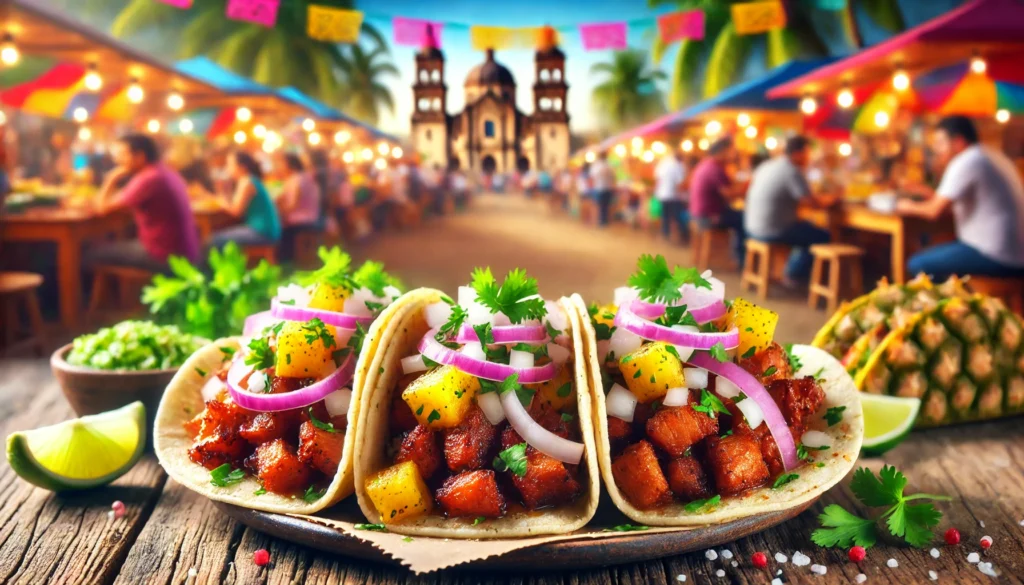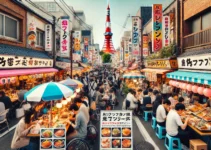Mexico City, a vibrant metropolis with a rich tapestry of history and culture, is a true paradise for food lovers. As one of the most diverse culinary landscapes in the world, Mexico City offers a delightful blend of traditional flavors, modern innovations, and everything in between. Whether you’re a seasoned foodie or just someone who loves a good taco, exploring the culinary delights of Mexico City is an adventure you won’t want to miss.

The Rich History of Mexican Cuisine
Mexican cuisine is a reflection of its rich history, with roots that go back thousands of years. The food in Mexico City is heavily influenced by indigenous cultures such as the Aztecs and the Maya, who laid the foundation for many traditional dishes. These cultures introduced staple ingredients like corn, beans, chilies, and chocolate, which remain integral to Mexican cooking today.
The Spanish colonization of Mexico brought new ingredients and cooking techniques, including the use of meat, dairy, and various spices. This fusion of indigenous and Spanish influences gave birth to the diverse and flavorful cuisine we know today.
Street Food: The Heart of Mexico City
If there’s one thing that defines the culinary scene in Mexico City, it’s street food. The bustling streets are filled with vendors serving mouthwatering dishes that are as diverse as they are delicious. Street food is an integral part of daily life in Mexico City, offering a taste of the city’s vibrant culture and community spirit.
Some must-try street foods include:
- Tacos: These iconic delights come in endless varieties, from tacos al pastor with marinated pork to tacos de carnitas with slow-cooked pork. Visit Taquería Los Cocuyos or El Vilsito for some of the best tacos in town.
- Elotes: Grilled corn on the cob slathered with mayonnaise, cheese, chili powder, and lime, elotes are a beloved snack.
- Tamales: Made from masa dough filled with meats, cheese, or sweet ingredients and wrapped in corn husks, tamales are a staple of Mexican street food.
For the best street food experience, head to areas like Coyoacán, La Condesa, and Roma Norte, where the streets come alive with the aroma of sizzling food.
Traditional Mexican Dishes
Beyond street food, Mexico City offers a wealth of traditional dishes that are a testament to the country’s culinary heritage. Some of the most famous include:
- Mole: A rich, complex sauce made with chocolate, chilies, and spices, often served over chicken or turkey. Puebla is renowned for its mole poblano, but you can find excellent versions at Restaurante Nicos in Mexico City.
- Pozole: A hearty soup made with hominy, pork or chicken, and a variety of toppings like lettuce, radishes, and lime. This comforting dish is perfect for a chilly evening.
- Chiles en Nogada: A seasonal dish made with poblano peppers stuffed with a mixture of meat and fruits, topped with a creamy walnut sauce and pomegranate seeds. It’s a beautiful dish that represents the colors of the Mexican flag.
To sample these traditional dishes, visit restaurants like El Cardenal and Azul Histórico, where you can savor authentic Mexican flavors.
The Role of Markets in Mexican Cuisine
Markets are the lifeblood of Mexico City’s culinary scene, offering a glimpse into the heart of Mexican food culture. Two of the most famous markets are Mercado de San Juan and La Merced, where you’ll find an array of fresh produce, meats, spices, and more.
Wandering through these bustling markets is an experience in itself. You’ll encounter vendors selling exotic ingredients like chapulines (grasshoppers) and huitlacoche (corn fungus), as well as artisans crafting handmade tortillas and salsas.
Don’t miss the chance to taste the food prepared at these markets, whether it’s a freshly made tlacoyo or a savory pambazo. The markets are also an excellent place to pick up unique ingredients to recreate Mexican dishes at home.
Exploring Modern Mexican Cuisine
While traditional flavors remain a cornerstone of Mexican cuisine, Mexico City is also at the forefront of culinary innovation. Chefs in the city are reimagining traditional dishes with modern techniques and global influences, creating a vibrant culinary landscape that continues to evolve.
Prominent chefs like Enrique Olvera at Pujol and Elena Reygadas at Rosetta are leading the charge in modern Mexican cuisine. These chefs are known for their creative takes on classic dishes, using locally sourced ingredients and innovative presentation.
Fusion cuisine is also gaining popularity, with restaurants blending Mexican flavors with international cuisines to create exciting new dishes. This culinary creativity adds another layer to Mexico City’s already rich food scene.
Sweets and Desserts
No exploration of Mexico City’s culinary delights would be complete without indulging in its sweets and desserts. From traditional pastries to decadent treats, there’s something to satisfy every sweet tooth.
Some popular Mexican desserts include:
- Churros: Deep-fried dough dusted with sugar and cinnamon, often served with a side of chocolate sauce for dipping.
- Flan: A creamy caramel custard that melts in your mouth.
- Tres Leches Cake: A sponge cake soaked in three types of milk, resulting in a moist and indulgent dessert.
For a sweet treat, visit places like El Moro for churros or Pastelería Ideal for a wide selection of traditional Mexican pastries.
Beverages: From Tequila to Aguas Frescas
In addition to its food, Mexico City offers a variety of beverages that are integral to its culinary culture. Whether you’re in the mood for something alcoholic or non-alcoholic, there’s no shortage of options to quench your thirst.
Alcoholic Beverages:
- Tequila: Made from the blue agave plant, tequila is Mexico’s most famous spirit. Try it straight or in a classic margarita.
- Mezcal: Known for its smoky flavor, mezcal is another agave-based spirit that has gained popularity in recent years.
- Pulque: A traditional alcoholic beverage made from the fermented sap of the agave plant, pulque has a unique flavor and a long history.
Non-Alcoholic Beverages:
- Horchata: A refreshing drink made from rice, cinnamon, and sugar.
- Agua de Jamaica: A tart and sweet hibiscus tea served cold.
- Atole: A warm, thick beverage made from masa, often flavored with chocolate or vanilla.
Exploring the diverse range of Mexican beverages is a delicious way to complement your culinary journey through Mexico City.
The Influence of Festivals on Mexican Cuisine
Mexican festivals play a significant role in the country’s culinary traditions, with specific dishes prepared to celebrate these occasions. Festivals provide an opportunity to experience the cultural significance of food in Mexican society.
During Dia de los Muertos (Day of the Dead), you’ll find Pan de Muerto, a sweet bread decorated with bone-shaped pieces. This bread is an essential part of the holiday’s offerings to honor deceased loved ones.
On Three Kings’ Day, families gather to enjoy Rosca de Reyes, a sweet bread shaped like a crown and adorned with candied fruits. Hidden inside the bread is a small figurine of baby Jesus, and the person who finds it is expected to host a tamale party on February 2nd.
Experiencing these festivals in Mexico City is a fantastic way to immerse yourself in the country’s culinary traditions and cultural celebrations.
Cooking Classes and Food Tours
For those who want to dive deeper into Mexican cuisine, taking a cooking class or joining a food tour is an excellent way to learn more about the ingredients, techniques, and history behind the dishes.
Cooking Classes: Many cooking schools in Mexico City offer classes where you can learn to make traditional dishes like mole, tamales, and guacamole. These classes provide hands-on experience and a deeper understanding of Mexican culinary traditions.
Food Tours: Joining a food tour allows you to explore different neighborhoods and taste a variety of dishes. Experienced guides share their knowledge of the city’s culinary history and introduce you to hidden gems you might not discover on your own.
Some popular food tour companies in Mexico City include Eat Mexico and Mexican Food Tours, both of which offer unique and engaging experiences for food enthusiasts.
Conclusion
Exploring the culinary delights of Mexico City is a journey that offers a taste of the country’s rich history, diverse culture, and innovative spirit. From the bustling street food scene to the refined flavors of modern Mexican cuisine, there’s something to satisfy every palate.
As you savor the flavors of Mexico City, you’ll gain a deeper appreciation for the cultural significance of food in this vibrant city. Whether you’re enjoying a simple taco on the street or dining at a world-class restaurant, each bite tells a story of tradition, creativity, and community.
So pack your bags and bring your appetite, because Mexico City is ready to take you on a culinary adventure you won’t soon forget!


